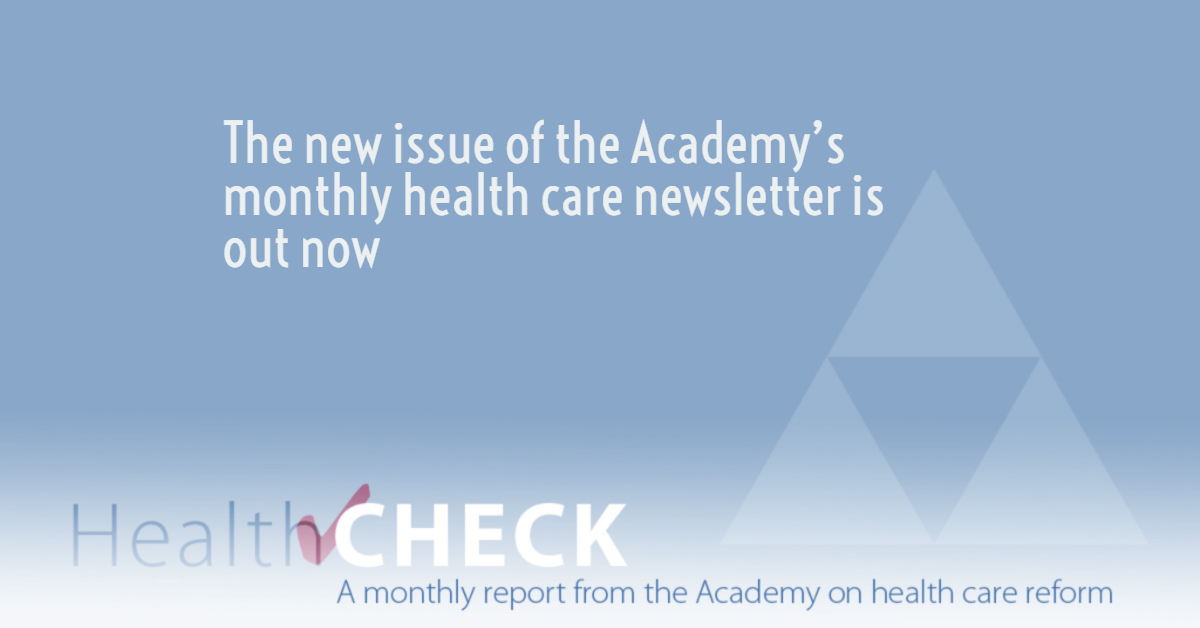Skip to content
This is an archived page
The content on this page may contain broken links or outdated information and should be used as reference only. If you require a specific resource from this page that is otherwise unavailable, contact us and we may be able to assist in finding it, or informing you the resource is no longer available to the Academy as well.
|
|
 |
|
|
Academy Activities
|
|
The Premium Review Work Group sent a letter to the leadership of the Massachusetts legislature on Senate bill No. 2447, which includes a provision that would deem “excessive” any health insurance premium increase that exceeds 150 percent of the increase in the medical consumer price index (CPI). The work group’s comments detailed some of the limitations of the medical CPI as a measure of the reasonableness of a premium increase.
|
|
|
Legislative and Regulatory Updates
 The Medicare Board of Trustees released its 2010 report on the financial solvency of Medicare on Aug. 5. With the lower expenditures and additional tax revenues projected as a result of the passage of the Patient Protection and Affordable Care Act (PPACA) earlier this year, the exhaustion date for Medicare hospital insurance (HI) trust fund assets is projected to be 2029 instead of 2017, as projected in last year’s report. In his statement of actuarial opinion, Centers for Medicare and Medicaid Chief Actuary Richard Foster clarifies that some of the PPACA payment updates may not be viable in the long term, meaning that the financial projections in the 2010 report may not “represent a reasonable expectation for actual program operations” in the short or long range. As such, the Office of the Actuary released an alternative illustrative scenario for projected Medicare expenditures. The Medicare Board of Trustees released its 2010 report on the financial solvency of Medicare on Aug. 5. With the lower expenditures and additional tax revenues projected as a result of the passage of the Patient Protection and Affordable Care Act (PPACA) earlier this year, the exhaustion date for Medicare hospital insurance (HI) trust fund assets is projected to be 2029 instead of 2017, as projected in last year’s report. In his statement of actuarial opinion, Centers for Medicare and Medicaid Chief Actuary Richard Foster clarifies that some of the PPACA payment updates may not be viable in the long term, meaning that the financial projections in the 2010 report may not “represent a reasonable expectation for actual program operations” in the short or long range. As such, the Office of the Actuary released an alternative illustrative scenario for projected Medicare expenditures.
 A federal district court judge in Virginia declined to dismiss on Aug. 2 a lawsuit brought by the Virginia attorney general that challenges the constitutionality of the PPACA individual mandate provisions. A summary judgment hearing has been scheduled for Oct. 18. A federal district court judge in Virginia declined to dismiss on Aug. 2 a lawsuit brought by the Virginia attorney general that challenges the constitutionality of the PPACA individual mandate provisions. A summary judgment hearing has been scheduled for Oct. 18.
 The Department of Health and Human Services (HHS) has published a number of new interim final regulations and clarifying documentation related to PPACA in the last two weeks: The Department of Health and Human Services (HHS) has published a number of new interim final regulations and clarifying documentation related to PPACA in the last two weeks:
-
A request for comments calling for public input as the department develops standards for the new state health insurance exchanges as directed by Title 1 of PPACA. Comments are due on or before Oct. 4. Applications for state grants to help with the design and establishment of health insurance exchanges are due by Sept. 1.
-
An interim final rule on July 30 related to the standards for administration of the new temporary high-risk pool, or the pre-existing condition insurance plan (PCIP). Comments are due on or before Sept. 28.
-
Clarifying guidance on July 27, in the form of a Q-and-A, regarding the interim final regulations published on June 28 that would implement provisions of PPACA that prohibit health insurers in the group and individual markets from excluding children with pre-existing conditions while they are under the age of 19.
|
|
|
In the News
Opinion pieces published by Newsday on July 24 and the Washington Times on July 26/27 cited the Academy’s adverse selection and sustainability concerns with the Community Living Assistance Services and Supports (CLASS) Act.
An Aug. 2/3 New York Times article regarding health care reform implementation cited the Academy’s Medical Loss Ratio (MLR) Regulation Work Group’s May 14 letter to the U.S. Department of Health and Human Services. The actuaries wrote that the new MLR requirements could “significantly disrupt the individual market” and cause “increased volatility in premium rates.”
Longtime Health Practice Council volunteer Tom Wildsmith offered an initial actuarial perspective on the 2010 Medicare trustees’ report in an Aug. 5 Bloomberg News report. Wildsmith, a member of the Academy’s Board of Directors, said that although the Medicare hospital insurance (HI) trust fund’s date of exhaustion has been put off for a few years, an underlying financial imbalance still remains.
News links are to external websites. The Academy is not responsible for the content of these websites.
|
|
|
|
|
|
|
|
|
|